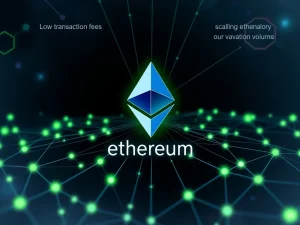Revolutionary Bank-Issued Stablecoin: Custodia and Vantage Bank Pioneer Avit on Ethereum

Hold onto your hats, crypto enthusiasts! A groundbreaking development has just dropped that could redefine how we perceive traditional finance and digital assets. Custodia Bank, known for its crypto-friendly stance, has teamed up with Vantage Bank to unleash what they’re calling America’s very first bank-issued stablecoin. Yes, you read that right – a stablecoin directly from the banking system, and it’s making waves in the crypto sphere.
What’s the Buzz Around This Bank-Issued Stablecoin?
In a nutshell, Custodia Bank and Vantage Bank have joined forces to tokenize US dollar deposits. Imagine your regular dollars in a bank account, but now they’re also living on the Ethereum blockchain as a stablecoin named ‘Avit’. This isn’t just another crypto project; it’s a bridge being built between conventional banking and the decentralized world of cryptocurrencies.
- Real US Dollars, Tokenized: Avit isn’t some synthetic derivative. It represents actual US dollars held in demand deposit accounts at Vantage Bank. This is crucial because it anchors the stablecoin to real-world assets, aiming for stability and trust.
- Ethereum’s Choice: Interestingly, Custodia Bank, initially known for its Bitcoin advocacy, chose Ethereum for this venture. This decision speaks volumes about Ethereum’s robust infrastructure and its growing dominance in the stablecoin and tokenized asset space.
- Regulatory Breakthrough: Custodia Bank CEO Caitlin Long emphasized the regulatory significance, stating they’ve proven that US banks can indeed tokenize deposits on permissionless blockchains while staying compliant. This could pave the way for more banks to explore similar innovations.
Why Ethereum for a Bank-Issued Stablecoin?
The choice of Ethereum as the blockchain for Avit is generating significant chatter, especially within the Ethereum community. Here’s why it’s a noteworthy decision:
- Ethereum’s Stablecoin Fortress: Ethereum already commands a lion’s share of the stablecoin market. It hosts over $125 billion worth of stablecoins, dwarfing competitors like Tron. This established ecosystem provides liquidity, infrastructure, and network effects that are hard to ignore.
- Tokenized US Treasuries Leader: Beyond stablecoins, Ethereum is also the leader in tokenizing real-world assets like US Treasury bills. It tokenizes seven times more US Treasury bills than its closest competitor, showcasing its prowess in bringing traditional assets onto the blockchain.
- Permissionless Innovation: Ethereum’s permissionless nature aligns with the ethos of decentralization. Custodia Bank highlighted this aspect, indicating a move towards open and accessible financial rails.
Ethereum proponents like Evan Van Ness and Anthony Sassano were quick to celebrate Custodia Bank’s choice, underscoring Ethereum’s capabilities in facilitating such innovative financial instruments. The community seems to view this as a validation of Ethereum’s technology and its growing role in bridging traditional and decentralized finance.
Avit: A Tokenized US Dollar – But How Does it Work?
Caitlin Long clarified that Avit is a “real dollar” stablecoin, not a “synthetic” one. This distinction is important, especially given recent discussions around stablecoin classifications. Here’s the breakdown:
- Demand Deposits as Backing: Avit is backed 1:1 by US dollar demand deposits held at Vantage Bank. Demand deposits are essentially funds in checking accounts, readily available for withdrawal. This direct backing provides a solid foundation for Avit’s value.
- ERC-20 Standard on Ethereum: Avit operates as an ERC-20 token on Ethereum. This standard is widely adopted, ensuring compatibility and ease of integration within the existing Ethereum ecosystem.
- New US Dollar Payment Rail: Custodia Bank boldly stated that a “new US dollar payment rail has now been activated inside the US banking system.” This suggests Avit could streamline payments and transactions within the banking system, leveraging the efficiency of blockchain technology.
The Future of Tokenized US Dollar and Bank-Issued Stablecoins
This partnership between Custodia Bank and Vantage Bank is more than just a news headline; it’s a potential glimpse into the future of finance. What could this mean for the broader landscape?
- Increased Adoption of Stablecoins: Legitimate, bank-issued stablecoins could foster greater trust and adoption among both institutions and individuals. The involvement of regulated banks may alleviate concerns around stability and regulatory compliance.
- Revolutionizing Payments: As Vantage Bank CEO Jeff Sinnott pointed out, this initiative demonstrates how blockchain and stablecoins can “revolutionize payments.” Expect to see more efficient, transparent, and potentially faster payment systems emerging.
- Bridging TradFi and DeFi: This move further blurs the lines between traditional finance (TradFi) and decentralized finance (DeFi). It showcases how banks are starting to explore and integrate blockchain technologies, potentially leading to a more interconnected financial ecosystem.
Conclusion: A Pivotal Moment for Bank-Issued Stablecoins
The launch of Avit, the first bank-issued stablecoin by Custodia Bank and Vantage Bank, is undoubtedly a landmark event. It signifies a major step towards integrating blockchain technology within the regulated banking system. By tokenizing US dollar demand deposits on Ethereum, they’ve not only created a new payment rail but also set a precedent for regulatory-compliant innovation in the crypto space. As the crypto world continues to evolve, keep a close watch on developments like Avit – they might just be shaping the future of money itself.










